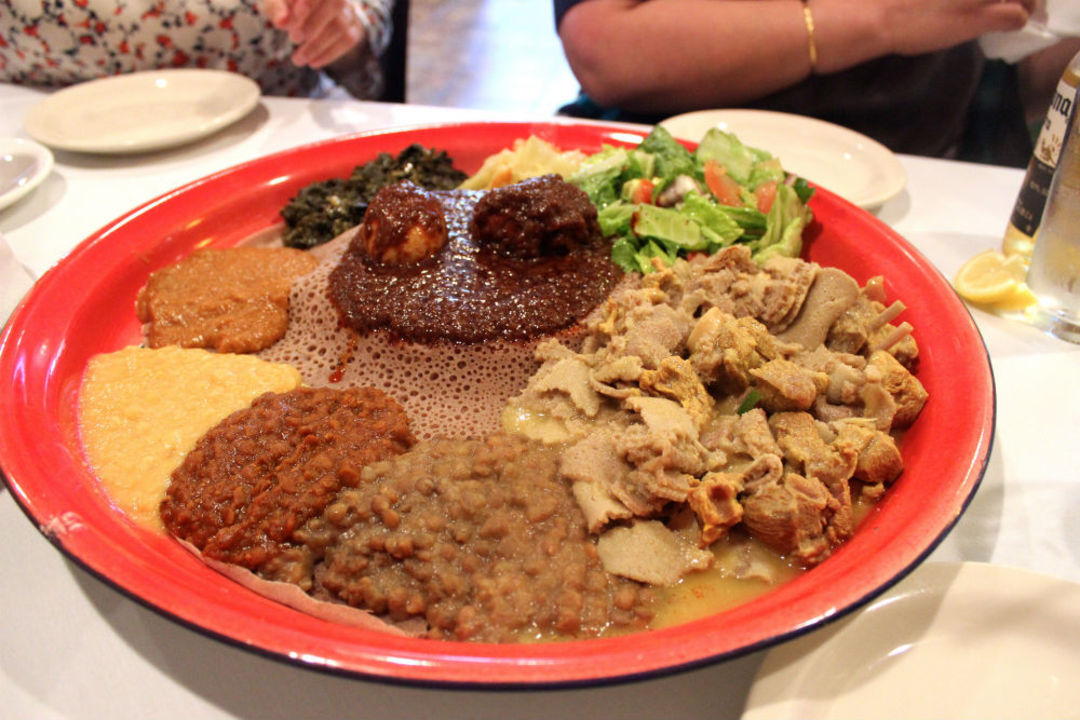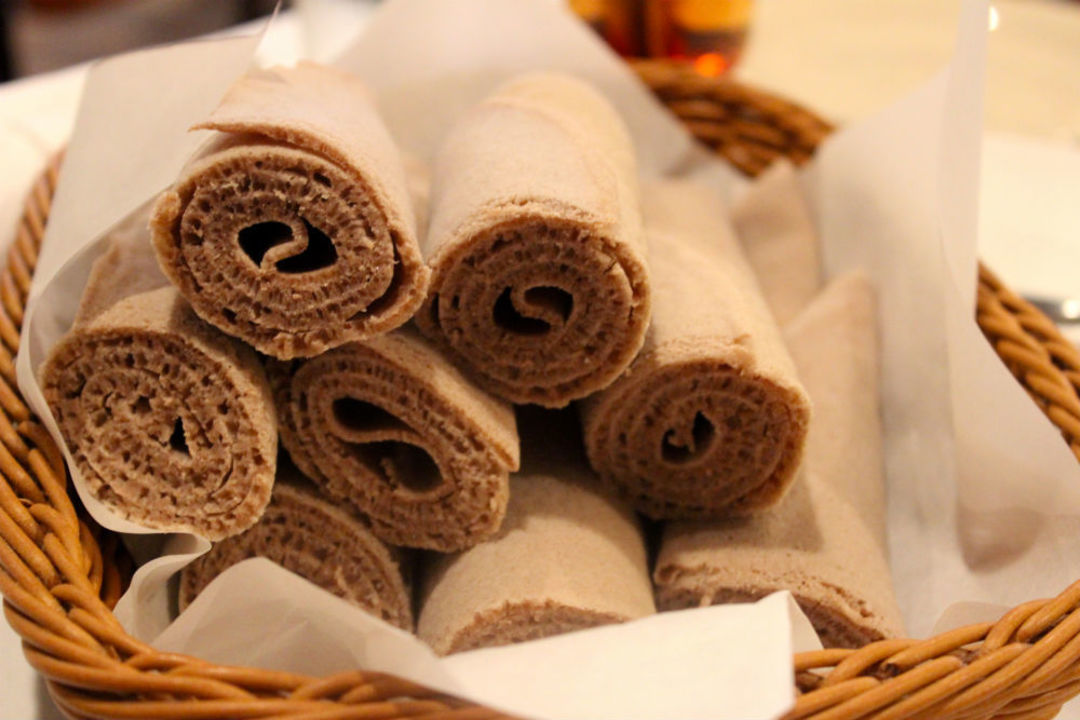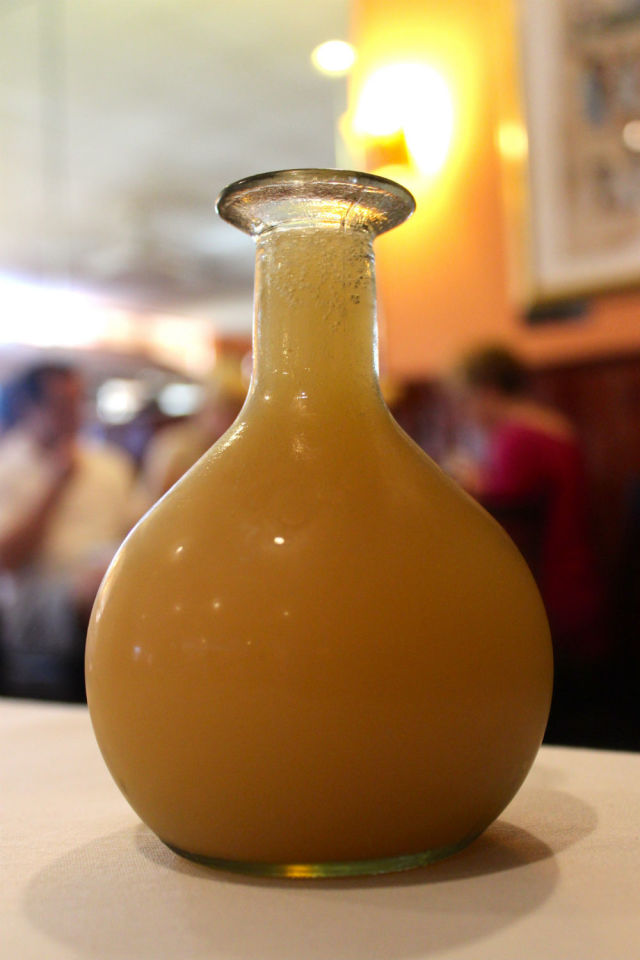Blue Nile: Houston's Ethiopian Heart for 20 Years

A vegetarian combo platter with doro wot (center) and lamb tibs.
Image: Katharine Shilcutt
The aftermath of a meal at Blue Nile is never pretty. Your fingers and nail beds, if you ordered the spicy, buttery doro wot—the restaurant's most popular dish—are probably stained a ruddy hue. You may have dribbled tej down your shirt as you attempted to drink the honey wine out of its awkwardly shaped glass jug. If you're anything like me, you may discover on the way to your car that you've somehow gotten lentils on your jeans.
"I've been eating here for 10 years," I muttered to my friends as they pointed out the dark yellow smear on my pants leg outside in the parking lot. "You'd think I'd be better at this by now."
"Ten years?" my best friend echoed. "Has it been here that long?" I nodded. At least 10 years, I thought. And then we all looked up at the restaurant's simple marquee, faded from years in the sunshine here on the far end of the Richmond Strip: "Blue Nile, since 1994."

A basket of injera bread at Blue Nile. Injera used as the main eating utensil (and is also made of teff, a complete protein that's naturally gluten-free).
When Blue Nile opened 20 years ago, our city had very little by way of African cuisine. The Houston Zagat guide in 1994 contains listings for Moroccan, Indonesian, Swiss, and even "Fondue" restaurants, but not a single African restaurant is included. The 1999 Zagat guide still didn't acknowledge Blue Nile's existence, although the family-run restaurant had been going strong for five years by this point.

Tej, fermented honey wine.
In the 20 years since Addis Ababa-born Tine Ameblue gave up her $4.25 per hour housekeeping job to open a restaurant with her daughter, Lillie, to cook the food of her homeland, Houston's African landscape has changed dramatically. Now, we have restaurants such as Lucy, offering a modern take on Ethiopian cuisine in a chic setting that's packed with young Houstonians of every color at night. We have stunning South African cuisine at Peli Peli. We even have an entire section of the city devoted to West African cuisine: in Little Nigeria—bounded by Bissonnet, Highway 59, and Beltway 8—you'll find Ghanian restaurants, Nigerian bars, and supermarkets selling all the ingredients to make your own goat pepper soup at home.
Blue Nile has changed, too. When I made my first nervous forays into the restaurant after returning to Houston from college, the small space inside a Richmond Avenue strip center was still a blank slate. It was clear Ameblue had opened the restaurant on a shoestring budget, with white walls and plain white tablecloths as the only real decoration aside from a few Ethiopian icons of St. George slaying his mythical dragon (St. George is the patron saint of the predominantly Christian country).
Today, Blue Nile's dining room is as vibrant as its food—the walls painted a rich saffron, a mahogany-clad bar serving Hennessey and Guinness, brightly colored mesobs strewn about (though more for decoration than function, as I've never seen anyone actually eating at the traditional Ethiopian tables), and though the same crisp white tablecloths remain, they're always topped with a single rose in a glass vase. This weekend, the roses were yellow tipped with a dark red.

Blue Nile now sports a window wrap featuring Ethiopian scenes and art.
Some will also complain that the prices at Blue Nile have risen in the past few years while the portions have decreased. I've noticed this trend too, though I'm not complaining, since it's clearly allowed Ameblue to turn her hole-in-the-wall restaurant into the sort of comfortable, welcoming place where you'll feel encouraged to try your very first plate of fitfit or tibs. I can't say the same thing for the Blue Nile I first visited in 2004—even as an adventurous diner, I was wary of the spare accommodations and confusing menu. These days, I'm eager to take friends to Blue Nile for their first Ethiopian coffee ceremony or to introduce them to the intoxicatingly spiced doro wot, grabbing up messy bites of the chicken stew with floppy tatters of injera bread, bonding as you all eat from the same big dish in the center of the table like you're family.
Just don't wear clothes you're too attached too, I tell them. And don't worry too much about those messy hands—you'll get a wash cloth at the end.




